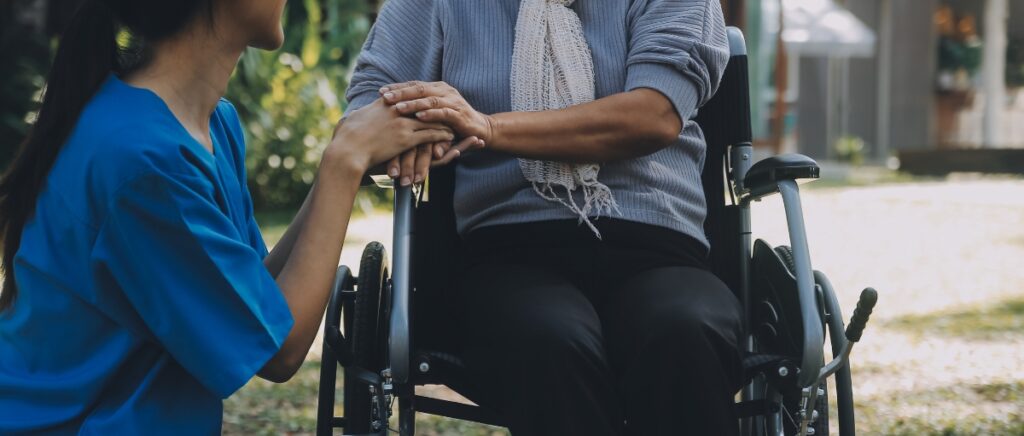If you’re one of the over 53 million Americans providing unpaid care to a loved one, you know firsthand the financial challenges it can bring. AARP’s 2021 study found that family caregivers spend an average of $7,242 per year on out-of-pocket caregiving expenses.
But here’s the good news—if that’s you, you may be eligible for financial assistance.
The economic burden of unpaid caregiving is substantial. Income-related losses for caregivers who leave the workforce early to care for a parent are estimated at over $300,000 on average in lost wages, benefits, and Social Security. This guide will walk you through the various available options, from Medicaid and Veterans benefits to state programs.
To find financial support while caring for a loved one, it’s essential to know how to become a caregiver for a family member. This article will guide you on how to get paid by the state for taking care of someone. In this article, you can learn how to get paid to take care of family members while ensuring they receive the necessary care. Let’s dive in.
How Much Do Family Members Get Paid for Caregiving?
If you’re wondering how much do family members get paid for caregiving, the amount family caregivers can get paid varies widely depending on the type of program, the state they live in, and their loved one’s specific care needs and financial situation. In general, caregivers can expect to receive anywhere from a few hundred to over $5,000 per month.
While there is significant variation, here are some common payment ranges:
- Medicaid personal care services: $12 to $15 per hour and up
- VA stipends: Monthly stipends of $1,751.98 to $2,803.17, per month
- Veterans benefit: Starting at $768 and up to $2,266, per month
- State programs: $200 to $1,000 per month
It’s important to note that these are rough ranges, and actual payments may be higher or lower. Sometimes, caregivers get paid to take care of family members by receiving a daily or monthly stipend rather than an hourly rate.
Key Factors That Impact Caregiver Compensation
Several factors can significantly impact how much a family caregiver gets paid:
- Medicaid eligibility: Qualifying for Medicaid can open up options like personal care services and waiver programs.
- Veteran status: Veterans and their spouses may be eligible for additional benefits.
- State of residence: Some states have more generous programs than others.
- Level of care required: Caregivers providing a higher level of care or more hours may receive higher payments.
- Income and assets: Some programs are need-based and consider the care recipient’s financial situation.
To learn how to get caregiver pay, explore Medicaid programs and state benefits that compensate family caregivers. Understanding eligibility and application processes can help you access the financial support you need.
Medicaid Options for Paid Family Caregiving
Medicaid is the largest source of funding for long-term care services in the United States. It offers several programs that allow family members to be paid for providing care. However, eligibility and program details vary widely by state.
1. HCBS Waivers and 1915(c) Waivers
Home and Community-Based Services (HCBS) waivers, also known as 1915(c) waivers, are state-specific programs that provide an alternative to nursing home care for family members. They allow states to “waive” certain Medicaid rules and provide services in home and community settings.
Eligibility
To qualify for an HCBS waiver, individuals must meet their state’s level of care criteria and financial eligibility requirements. Income limits vary but are typically higher than regular Medicaid.
Consumer-Directed Options
Most HCBS waivers include a consumer-directed option, which allows participants to hire and manage their own caregivers, including family members. In some states, this is called “participant-directed services” or “self-directed care.”
Payment Structure
Under a consumer-directed model, caregivers are typically paid an hourly rate determined by the state. Rates can range from $9 to $19 per hour, depending on the state and the specific services provided.
How to Apply
To apply for an HCBS waiver, contact your state Medicaid agency or local aging and disability resource center. Be aware that many waivers have waiting lists due to limited slots.
2. Medicaid Personal Care Services
Medicaid personal care services (PCS) are a state plan benefit that provides assistance with activities of daily living (ADLs) such as bathing, dressing, and grooming. Some states allow family members to be hired as personal care attendants.
Eligibility
To qualify for PCS, individuals must meet their state’s functional and financial eligibility criteria for Medicaid. Income and asset limits vary by state.
Consumer-Directed Options
Many states offer a consumer-directed option for PCS, allowing participants to hire caregivers, including family members. This may be called “self-directed personal assistance services” or “participant-directed personal care.”
Payment Structure
Under a consumer-directed model, caregivers are typically paid an hourly rate determined by the state. Rates can range from $9 to $15 per hour, depending on the state and the specific services provided.
How to Apply
To apply for Medicaid personal care services, contact your state Medicaid agency or local aging and disability resource center.
3. Medicaid Caregiver Exemption
The Medicaid caregiver exemption, also known as the “child caregiver exemption,” allows an adult child to become a paid caregiver for their parent without having the parent’s home counted as an asset for Medicaid eligibility purposes.
Eligibility
To qualify, the adult child must live with the parent and provide care for at least two years prior to the parent entering a nursing home. The level of care must meet the state’s criteria for nursing home level of care.
Payment Structure
Under this arrangement, the caregiver is paid through a personal care agreement between the parent and child. The payment amount should be reasonable and based on fair market rates for the services provided.
How to Apply
Consult with a Medicaid planning attorney or your local Medicaid office to learn more about the caregiver exemption and how to set up a personal care agreement.
4. Adult Foster Care
In some states, Medicaid allows family members to become paid adult foster care providers for their elderly parents. The parent moves into the adult child’s home, and the child receives payment for providing housing, meals, and personal care services.
Eligibility
Eligibility criteria vary by state but typically include functional and financial requirements. The adult child’s home must also meet certain safety and accessibility standards.
Payment Structure
The state determines payment rates for adult foster care, which may include a stipend for room and board and a daily or monthly rate for caregiving services.
How to Apply
Contact your local Medicaid office or aging and disability resource center to learn more about adult foster care options in your state and how to become a certified provider.
Veterans Programs That Pay Family Caregivers
The Department of Veterans Affairs (VA) offers several programs that provide financial support to veteran family caregivers.
1. Veteran-Directed Care
The Veteran-Directed Care program, formerly known as Veteran-Directed Home and Community-Based Services, allows veterans to manage their own long-term care services and supports. Veterans have the option to hire family as paid caregivers to provide personal care services.
Eligibility
To qualify, veterans must be enrolled in the VA healthcare system and meet the clinical criteria for the program. They must also live in a participating VA Medical Center area.
Payment Structure
Caregivers are paid an hourly rate determined by the VA, which varies based on geographic location and the veteran’s care needs. Rates typically range from $12 to $24 per hour.
How to Apply
Contact your local VA Medical Center or visit the Veteran-Directed Care website to learn more and apply.
2. VA Aid and Attendance and Housebound Pensions
The VA offers two pension programs that can help pay for in-home care: Aid and Attendance (A&A) and Housebound. These benefits are paid in addition to a veteran’s regular pension.
Eligibility
To qualify, veterans must meet service requirements, have a documented need for care, and meet income and asset limits. Surviving spouses may also be eligible.
Payment Structure
A&A and Housebound benefits are paid directly to the veteran or surviving spouse. The amount varies based on the individual’s income and care needs but can range from a few hundred to over $2,000 per month.
How to Apply
Apply online through the VA website or contact your local VA office for assistance.
State-Based Non-Medicaid Programs
Many states offer their own programs to support family caregivers, separate from Medicaid. These programs vary widely in terms of eligibility, services provided, and payment rates.
Some common types of state-based caregiver support programs include:
- Cash and Counseling: Provides a monthly allowance for participants to hire their own caregivers.
- Caregiver Support and Respite: Offers training, counseling, and short-term relief for family caregivers.
- Consumer-Directed Personal Assistance: Allows participants to hire and manage their own caregivers.
Together, these initiatives aim to empower participants and provide vital respite care.
Eligibility and How to Apply
Eligibility criteria and application processes vary by state and program. Contact your local Area Agency on Aging or Department of Human Services to learn about programs in your area and how to apply.
Other Options to Pay Family Caregivers
- Long-Term Care Insurance: If your loved one has a long-term care insurance policy, it may cover in-home care provided by family members. Check the policy details or contact the insurance company to learn more.
- Life Insurance: Some life insurance policies can be converted into a “life settlement” to pay for long-term care costs, including paying family caregivers. Consult with a financial advisor or elder law attorney to explore this option.
- Paid Family Leave: A growing number of states have implemented paid family leave laws that allow workers to take time off with partial pay to care for a family member. Check if your state offers this benefit and how to apply.
- Tax Credits and Deductions: Family caregivers may be eligible for certain tax credits and deductions, such as the Child and Dependent Care Credit or the Medical and Dental Expenses Deduction. Consult with a tax professional to learn more.
Securing the Support You Deserve as a Family Caregiver
Providing long-term care for an aging loved one can be a rewarding but challenging experience, both emotionally and financially. You can find ways to receive compensation for your caregiving efforts by exploring the various programs and options available.
Eligibility and application processes can differ significantly; therefore, it’s crucial to research your options thoroughly. Additionally, seeking advice from local resources can provide valuable guidance. Don’t hesitate to seek support—you deserve it.
Contact your local Area Agency on Aging, Medicaid office, or Veterans Affairs representative for more information and personalized assistance. They can help guide you through the process and connect you with the resources you need to thrive as a family caregiver.
Sources
AARP. (n.d.). Caregiving in the United States. AARP. https://www.aarp.org/pri/topics/ltss/family-caregiving/caregiving-in-the-united-states/
AARP. (2021, June 29). AARP research shows family caregivers face significant financial strain, spend on average $7,242 each year. AARP. https://press.aarp.org/2021-6-29-AARP-Research-Shows-Family-Caregivers-Face-Significant-Financial-Strain,-Spend-on-Average-7,242-Each-Year
National Academies of Sciences, Engineering, and Medicine. (2016). Families caring for an aging America. National Academies Press. https://www.ncbi.nlm.nih.gov/books/NBK396402/
Institute on Aging. (n.d.). Can a family member get paid to be a caregiver in California? Caring for aging loved ones. Institute on Aging. https://www.ioaging.org/aging/can-family-member-get-paid-caregiver-california-caring-aging-loved-ones/
Sacramento County Veterans Services. (n.d.). VA Caregiver Support Program FAQ. Sacramento County. https://ha.saccounty.gov/benefits/VeteransServices/FAQ%20docs/VA%20Caregiver%20Support%20Program%20FAQ.pdf
National Veterans Foundation. (n.d.). VA aid and attendance benefits. National Veterans Foundation. https://nvf.org/va-aid-and-attendance-benefits/
Medicaid.gov. (n.d.). Home and community-based services 1915(c). Medicaid. https://www.medicaid.gov/medicaid/home-community-based-services/home-community-based-services-authorities/home-community-based-services-1915c/index.html
Medicaid Planning Assistance. (n.d.). Child caregiver exemption. Medicaid Planning Assistance. https://www.medicaidplanningassistance.org/child-caregiver-exemption/
U.S. Department of Veterans Affairs. (n.d.). Veteran-directed care. U.S. Department of Veterans Affairs. https://www.va.gov/geriatrics/pages/Veteran-Directed_Care.asp
U.S. Department of Veterans Affairs. (n.d.). VA pension: Aid and attendance/housebound. U.S. Department of Veterans Affairs. https://www.va.gov/pension/aid-attendance-housebound/
Administration for Community Living. (n.d.). Area Agencies on Aging (AAA). Administration for Community Living. https://eldercare.acl.gov/Public/About/Aging_Network/AAA.aspx











